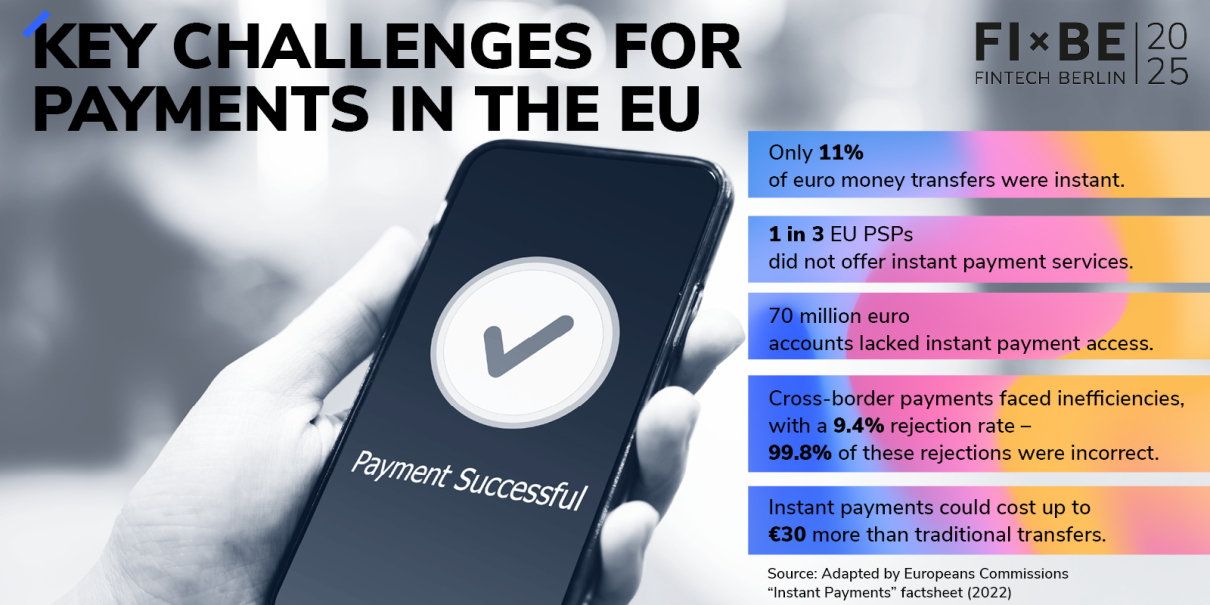Page content
The Impact of IPR, PSR and PSD3
Reading Time: 3:30 Minutes
The European payments landscape is undergoing a profound transformation, driven by a series of regulatory initiatives and technological advancements. If the impact of AI on fintech has gained significant attention, thanks also to the EU AI Act, there are key new regulations, like the Instant Payments Regulation (IPR), the Payment Services Regulation (PSR) and the third Payment Services Directive (PSD3), that are set to transform European payments and the fintech space.
On top of that, the EU's Markets in Crypto-Assets (MiCA) regulation and the future introduction of the digital euro, add to this transformation, presenting both increasing complexity and additional opportunities.
Here we analyze these new regulations and their potential impact on the fintech industry in Europe.
Understanding the current landscape
Insights from the European Commission's "Instant Payments" factsheet (2022) revealed some key challenges for payments in the EU:
- Only 11% of euro money transfers were instant.
- 1 in 3 EU PSPs did not offer instant payment services.
- 70 million euro accounts lacked access to instant payments.
- Cross-border payments faced inefficiencies, with a 9.4% rejection rate—99.8% of these rejections were incorrect.
- Instant payments could cost up to €30 more than traditional transfers.
According to European Central Bank (ECB) data, released in 2024, and analyzing the second half of 2023, instant credit transfers reached 14% of the total credit transfer volume, showing a moderate increase in adoption from the 2022 baseline.

Instant Payments Regulation (IPR)
The Instant Payments Regulation (IPR), which entered into force on April 8, 2024, represents a fundamental shift for our payment infrastructure. The regulation mandates that all payment service providers (PSPs) in the EU offer instant payment capabilities, enabling consumers and businesses to send and receive Euro payments within seconds, 24/7, to any country within the Single Euro Payments Area (SEPA).
The regulation introduces a phased implementation timeline to ensure a smooth transition:
For EU-based PSPs:
- Receiving instant credit transfers: January 9, 2025
- Sending instant credit transfers: October 9, 2025
Extra-EU PSPs:
- Receiving instant credit transfers: January 9, 2027
- Sending instant credit transfers: July 9, 2027
This phased approach allows PSPs to adapt gradually while ensuring significant improvements in speed, convenience, and security that will benefit both businesses and consumers. The staggered deadlines also acknowledge the different operational complexities faced by EU and non-EU providers, while maintaining the ultimate goal of a comprehensive instant payments network across the SEPA region.
Payment Services Regulation (PSR)
The Payment Services Regulation (PSR) aims to foster competition and innovation in the payments sector. It introduces several key measures, including ensuring fair and open access to payment systems and infrastructures, promoting the use of open standards and interoperability to ensure seamless communication between different payment systems and encouraging the development of new payment solutions.
The PSR also strengthens consumer protection by introducing stricter security requirements and liability rules for unauthorized transactions. By creating a level playing field and removing barriers to entry, the PSR is expected to stimulate the emergence of new players and innovative payment services.
Payment Services Directive (PSD3)
The upcoming Payment Services Directive (PSD3), complements the PSR as part of a broader payment services package. Building on the open banking provisions of PSD2, PSD3 aims to further enhance competition, innovation, and consumer protection within the payments space. It introduces clearer rules on data sharing, security, and liability when engaging with third-party providers.
PSD3 also addresses key challenges from PSD2, such as inconsistencies in its implementation across Member States and gaps in cybersecurity. By refining these provisions, PSD3 empowers consumers with improved access to financial services while driving the growth of open banking and the broader fintech ecosystem.
Timeline and Integration
Although the IPR has already entered into force, PSD3 and the PSR are still at the draft stage. Approval is expected during 2025, but enforcement will likely begin by late 2026 or early 2027.
PSD3 is expected to align with other key regulations, such as the Markets in Crypto Assets (MiCA) regulation, which came into effect on December 30, 2024. This alignment is aimed to ensure a consistent and comprehensive regulatory framework for emerging instruments like crypto currencies and stablecoins.
Additionally, the European Central Bank's exploration of a central bank digital currency (CBDC), including the digital euro, represents another significant development in the evolving payments landscape.
Future Prospects and Conclusion
These new regulations mark a transformative shift in European payments. By establishing clear rules and standardized processes, they create opportunities for fintechs to innovate, enhance customer experiences, and expand cross-border operations while fostering a secure, inclusive ecosystem.
For deeper insights into these regulatory changes, join us at FIBE 2025 this April for two days of fintech talks and discussions. Of particular relevance to the topics discussed in this article are the sessions from Burkhard Balz, member of the Executive Board at Deutsche Bundesbank, who will examine how the Digital Euro will reshape the payments landscape, and the joint session with Matt Colebourne, CEO at Qwist Group, and Ferdinand Dabitz, Co-Founder & CEO at Ivy, focusing on how PSD3 and instant payments are reshaping open banking and the future of finance.

